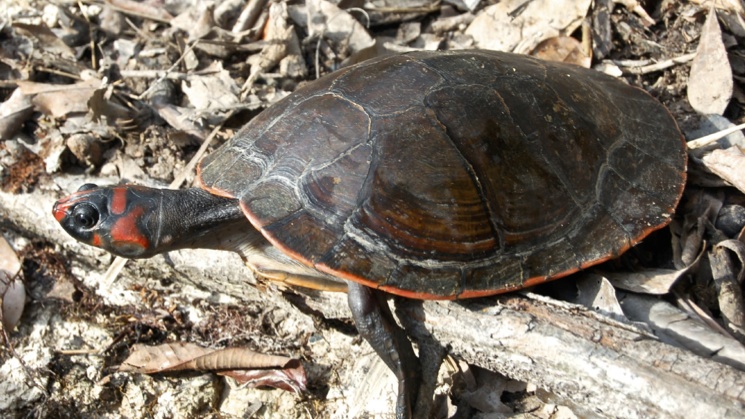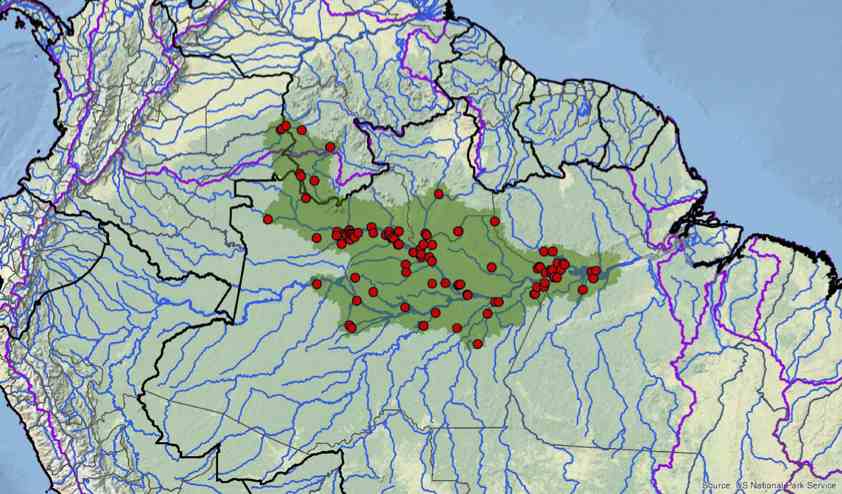Podocnemis erythrocephala, 087
Podocnemis erythrocephala (Spix 1824) –
Red-headed Amazon River Turtle, Irapuca
Russell A. Mittermeier1, Richard C. Vogt2,
Rafael Bernhard3, and Camila R. Ferrara4
1Conservation International, 2011 Crystal Drive, Suite 500,
Arlington, Virginia 22202, USA [[email protected]];
2Instituto Nacional de Pesquisas da Amazônia, Coordinação de Biodiversidade,
Caixa Postal 2223, Petrópolis, Manaus, Amazonas, Brazil 69080-971 [[email protected]];
3Centro de Estudos Superiores de Tefé, Universidade do Estado do Amazonas,
Estrada do Bexiga 1085, Bairro Jerusalém, Tefé, Amazonas, Brazil 69470-000 [[email protected]];
4Wildlife Conservation Society, Manaus, Amazonas, Brazil 69080 [[email protected]]
Summary. – The Red-Headed Amazon River Turtle, Podocnemis erythrocephala (Family Podocnemididae), is the smallest species in its genus, with a maximum straight carapace length of 322 mm in females and 244 mm in males. It inhabits primarily smaller blackwater streams and flooded forests rather than main river channels. It is primarily herbivorous and nests on sandy beaches associated with open shrub or grassland along black or clearwater rivers, streams, and lakes. Females produce up to four clutches per year, with 2–18 eggs per clutch. The species is threatened by unregulated hunting of adults and egg gathering at the nesting beaches for food and black market sales, in spite of national laws protecting the species in each of the three countries where it occurs.
Distribution. – Brazil, Colombia, Venezuela. Occurs primarily in the Rio Negro Basin of Brazil and neighboring Venezuela and Colombia, but also in the lower Rio Solimões and upper Rio Amazonas basins of Brazil and the upper Orinoco Basin of Venezuela and Colombia.
Synonymy. – Emys cayennensis Schweigger 1812 (partim, misidentified type), Chelys (Hydraspis) cayennensis, Chelys cayennensis, Hydraspis cayennensis, Podocnemis cayennensis, Emys erythrocephala Spix 1824, Podocnemis erythrocephala, Hydraspis expansa erythrocephala, Chelys (Hydraspis) erythrocephala, Chelys erythrocephala, Emys bitentaculata Cuvier in Gray 1830 (nomen nudum et dubium), Hydraspis bitentaculata Gray 1831 (nomen oblitum et dubium), Podocnemis agassizii Coutinho in Göldi 1886, Podocnemis coutinhii Göldi 1886 (nomen novum).
Subspecies. – None currently recognized.
Status. – IUCN 2014 Red List: Vulnerable (VU A1bd; assessed 1996); TFTSG Draft Red List: Vulnerable (VU, assessed 2011); Brazil: Near Threatened (NT); Colombia: Vulnerable (VU A1acd+2cd); CITES Appendix II (as Podocnemis spp.).
Citation:
Mittermeier, R.A., Vogt, R.C., Bernhard, R., and Ferrara, C.R. 2015. Podocnemis erythrocephala (Spix 1824) – Red-headed Amazon River Turtle, Irapuca. In: Rhodin, A.G.J., Pritchard, P.C.H., van Dijk, P.P., Saumure, R.A., Buhlmann, K.A., Iverson, J.B., and Mittermeier, R.A. (Eds.). Conservation Biology of Freshwater Turtles and Tortoises: A Compilation Project of the IUCN/SSC Tortoise and Freshwater Turtle Specialist Group. Chelonian Research Monographs 5(8):087.1–10, doi:10.3854/crm.5.087.erythrocephala.v1.2015, //iucn-tftsg.org/cbftt/.
(Adobe Acrobat 6.0 or later required)

Adult male Podocnemis erythrocephala from Rio Jufari, a tributary of the Rio Negro, Amazonas, Brazil.
Photo by Richard C. Vogt.
Distribution:

Distribution of Podocnemis erythrocephala in Brazil, Colombia, and Venezuela in northern South America. Purple lines = boundaries delimiting major watersheds (level 3 hydrologic unit compartments – HUCs); red dots = museum and literature occurrence records based on Iverson (1992) plus more recent data, and the authors’ personal data; green shading = projected historic native distribution based on GIS-defined level 10 HUCs constructed around verified localities and then adding HUCs that connect known point localities in the same watershed or physiographic region, and similar habitats and elevations as verified HUCs (Buhlmann et al. 2009; TTWG 2014), and adjusted based on authors’ subsequent data.








